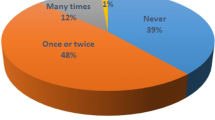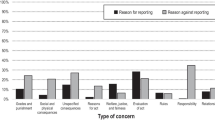Abstract
Using student self-reported cheating admissions and answers from a hypothetical cheating scenario, this paper analyzes the effects of individual and situational factors on potential cheating behavior. Results confirm several conclusions about student factors that are related to cheating. The probability of cheating is associated with younger students, lower GPAs, alcohol consumption, fraternity/sorority membership, and having cheated in high school. Student perceptions of the certainty and severity of punishment appear to have a negative and significant impact on the probability of cheating on in-class assignments. Students who report a belief that cheating is never acceptable appear to be significantly less likely to cheat in any circumstance. This study illustrates the context-dependent nature of academic dishonesty, and the associated difficulty in understanding the relationships between measurable factors and cheating behavior.

Similar content being viewed by others
Notes
While cheating at the university level is rampant, Jensen et al. (2002) show that high school students cheat more than college students.
Crown and Spiller (1998) provide a review of individual and situational factors related to college cheating.
McCabe and Trevino (1997) suggest that fraternity/sorority membership could be treated as a contextual factor rather than an individual factor, as fraternities/sororities provide the context through which cheating norms and skills are transmitted, as well as access to resources that facilitate cheating.
To protect anonymity and allow for the assignment of bonus points, survey respondents were given a code word at the end of the survey. Students were instructed to write the code word on their final exam for bonus points.
The survey instrument also included two simple questions to gauge whether or not students were reading the questions and responses carefully, placed roughly one-third and two-thirds through the survey. Students who did not provide logical answers to these questions were also removed from the sample.
As correlations between attribute levels could confound the estimation of the effect of attributes on the stated probability of cheating, the scenarios were developed such that the correlations between factors were minimized across the 12 scenarios. The range of Pearson correlation coefficients in the final design was -0.20 – 0.298. The average of the absolute values of the 21 Pearson correlation coefficients was 0.15.
In other words, we assume that “probably would not cheat” can be interpreted as “might cheat”.
The null hypothesis of no relationship between the any of the predictor variable and the outcome is rejected at the 1 % significance level for all models using Chi-Square tests.
Multicollinearity between the witness others cheating variable and student beliefs about the prevalence of cheating may affect the results of Models 3 and 6.
References
Baetz, M., Zivcakova, L., Wood, E., Nosko, A., De Pasquale, D., & Archer, K. (2011). Encouraging active classroom discussions of academic integrity and misconduct in higher education business contexts. Journal of Academic Ethics, 9, 217–234.
Baird, J. S., Jr. (1980). Current trends in college cheating. Psychology in the Schools, 17(4), 515–522.
Barnes, W. F. (1975). Test information: an application of the economics of search. The Journal of Economic Education, 7, 28–33.
Brown, B. S., & Emmett, D. (2001). Explaining variations in the level of academic dishonesty in studies of college students: some new evidence. College Student Journal, 35, 529–538.
Bunn, D. N., Caudill, S. B., & Gropper, D. M. (1992). Crime in the classroom: an economic analysis of undergraduate student cheating behavior. Journal of Economic Education, 23(Summer), 197–207.
Burrus, R. T., McGoldrick, K. M., & Schuhmann, P. W. (2007). Crime in the classroom: does a definition of cheating matter? The Journal of Economic Education, 38(1), 3–16.
Chonko, L. B., Tanner, J. F., & Weeks, W. A. (1996). Ethics in salesperson decision making: a synthesis of research approaches and an extension of the scenario method. Journal of Personal Selling & Sales Management, 16(Winter), 35–52.
Cochran, J. K., Chamlin, M. B., Wood, P. B., & Sellers, C. S. (1999). Shame, embarrassment, and formal sanction threats: extending the deterrence/rational choice model to academic dishonesty. Sociological Inquiry, 69(1), 91–105.
Covey, M. K., Saladin, S., & Killen, P. J. (1989). Self-monitoring, surveillance, and incentive effects on cheating. Journal of Social Psychology, 129, 673–679.
Crown, D. F., & Spiller, M. S. (1998). Learning from the literature on collegiate cheating: a review of empirical research. Journal of Business Ethics, 17(6), 683–700.
Fishbein, M., & Ajzen, I. (1975). Belief, attitude, intention, and behavior. Reading: Addison-Wesley.
Gardner, W. M., Roper, T., & Gonzalez, C. C. (1988). Analysis of cheating on academic assignments. Psychological Record, 38(Fall), 543–555.
Green, D. (1989). Measures of illegal behavior in individual-level deterrence research. Journal of Research in Crime and Delinquency, 26(3), 253–275.
Grimes, P. W., & Rezek, J. P. (2005). The determinants of cheating by high school economics students: a comparative study of academic dishonesty in the transitional economies. International Review of Economics Education, 4(2), 23–45.
Higgins, G. E., & Ricketts, M. L. (2004). Motivation or opportunity: which serves as the best mediator in self-control theory? Western Criminology Review, 5(2), 77–96.
Hollinger, R. C., & Lanza-Kaduce, L. (2009). Academic dishonesty and the perceived effectiveness of countermeasures: an empirical survey of cheating at a major public university. NASPA Journal, 46(4), 587–602.
Honeycutt, E. D., Jr., Glassman, M., Zugelder, M. T., & Karande, K. (2001). Determinants of ethical behavior: a study of autosalespeople. Journal of Business Ethics, 32(1), 69–79.
Houston, J. P. (1986). Classroom answer copying: roles of acquaintanceship and free versus assigned seating. Journal of Educational Psychology, 78(June), 230–232.
Iyer, R., & Eastman, J. (2006). The Journal of Education for Business, 82(2), 101–110.
Jackson, C. J., Levine, S. Z., Furnham, A., & Burr, N. (2002). Predictors of cheating behavior at a university: a lesson from the psychology of work. Journal of Applied Social Psychology, 32(5), 1031–1046.
Jenson, L., Arnett, J., Feldman, S., & Cauffman, E. (2002). It’s wrong, but everybody does It: academic dishonesty among high school and college students. Contemporary Education Psychology, 27, 209–228.
Jones, G. E., & Kavanagh, M. J. (1996). An experimental examination of the effects of individual and situational factors on unethical behavioral intentions in the workplace. Journal of Business Ethics, 15(5), 511–523.
Karlins, M., Michaels, C., & Podlogar, S. (1988). An empirical investigation of actual cheating in a large sample of undergraduates. Research in Higher Education, 29(4), 359–364.
Kerkvliet, J. (1994). Cheating by economics students: a comparison of survey results. The Journal of Economic Education, 27(2), 121–133.
Kerkvliet, J., & Sigmund, C. L. (1999). Can we control cheating in the classroom? The Journal of Economic Education, 30(4), 331–343.
Klein, H. A., Levenburg, N. M., McKendall, M., & Mothersell, W. (2007). Cheating during the college years: how do business school students compare? Journal of Business Ethics, 72(2), 197–206.
McCabe, D. L., & Trevino, L. K. (1993). Academic dishonesty: honor codes and other contextual influences. Journal of Higher Education, 64(5), 522–538.
McCabe, D. L., & Trevino, L. K. (1995). Cheating among business students: a challenge for business leaders and educators. Journal of Management Education, 19(2), 205–218.
McCabe, D. L., & Trevino, L. K. (1997). Individual and contextual influences on academic dishonesty: a multicampus investigation. Research in Higher Education, 38(3), 379–396.
McCabe, D. L., Trevino, L. K., & Butterfield, K. D. (2001). Cheating in academic institutions: a decade of research. Ethics and Behavior, 11(3), 219–232.
McCabe, D. L., Trevino, L. K., & Butterfield, K. D. (2002). Honor codes and other contextual influences on academic integrity: a replication and extension to modified honor code settings. Research in Higher Education, 43(3), 357–378.
Meade, J. (1992). Cheating: is academic dishonesty par for the course? PRism, 1(7), 30–32.
Mixon, F. G., Jr. (1996). Crime in the classroom: an extension. Journal of Economic Education, 27(3), 195–200.
Mixon, F. G., Jr., & Mixon, D. C. (1996). The economics of illegitimate activities: further evidence. Journal of Socio-Economics, 25(3), 373–381.
Murray, G. F., & Erickson, P. G. (1987). Cross-sectional versus longitudinal research: an empirical comparison of projected and subsequent criminality. Social Science Research, 16(2), 107–118.
Nowell, C., & Laufer, D. (1997). Undergraduate student cheating in the fields of business and economics. The Journal of Economic Education, 28(1), 3–12.
Park, C. (2003). In other (People’s) words: plagiarism by university students - literature and lessons. Assessment and Evaluation in Higher Education, 28, 471–488.
Roig, M., & Ballew, C. (1994). Attitudes toward cheating of self and others by college students and professors. Psychological Record, 44(1), 3–12.
Spiller, M. S., & Crown, D. F. (1995). Changes over time in academic dishonesty at the collegiate level. Psychological Reports, 76, 763–768.
Tibbetts, S. G. (1999). Differences between women and Men regarding decisions to commit test cheating. Research in Higher Education, 40(3), 323–342.
Tittle, C., & Rowe, A. (1974). Fear and the student cheater. Change, 6(3), 47–48.
West, T., Ravenscroft, S. P., & Shrader, C. B. (2004). Cheating and moral judgment in the college classroom: a natural experiment. Journal of Business Ethics, 54(2), 173–183.
Whitley, B. E., Jr. (1998). Factors associated with cheating among college students: a review. Research in Higher Education, 39(3), 39.
Acknowledgments
Support for this research was provided by a grant from the Cameron School of Business at the University of North Carolina Wilmington.
Author information
Authors and Affiliations
Corresponding author
Rights and permissions
About this article
Cite this article
Schuhmann, P.W., Burrus, R.T., Barber, P.D. et al. Using the Scenario Method to Analyze Cheating Behaviors. J Acad Ethics 11, 17–33 (2013). https://doi.org/10.1007/s10805-012-9173-4
Published:
Issue Date:
DOI: https://doi.org/10.1007/s10805-012-9173-4




